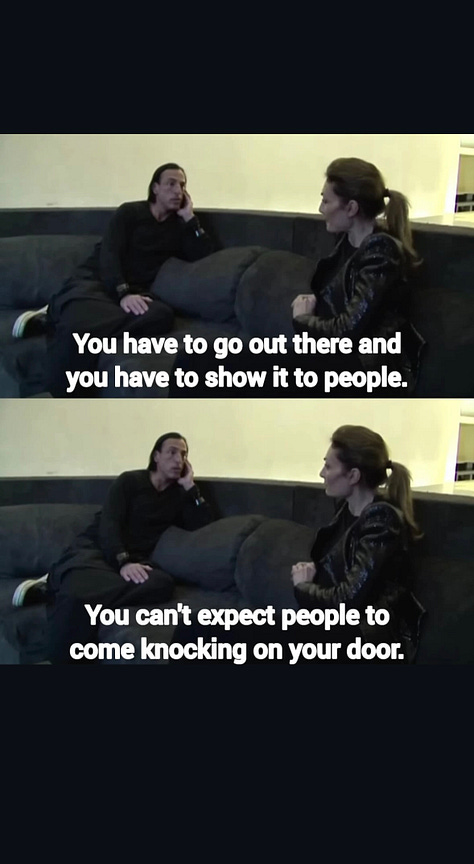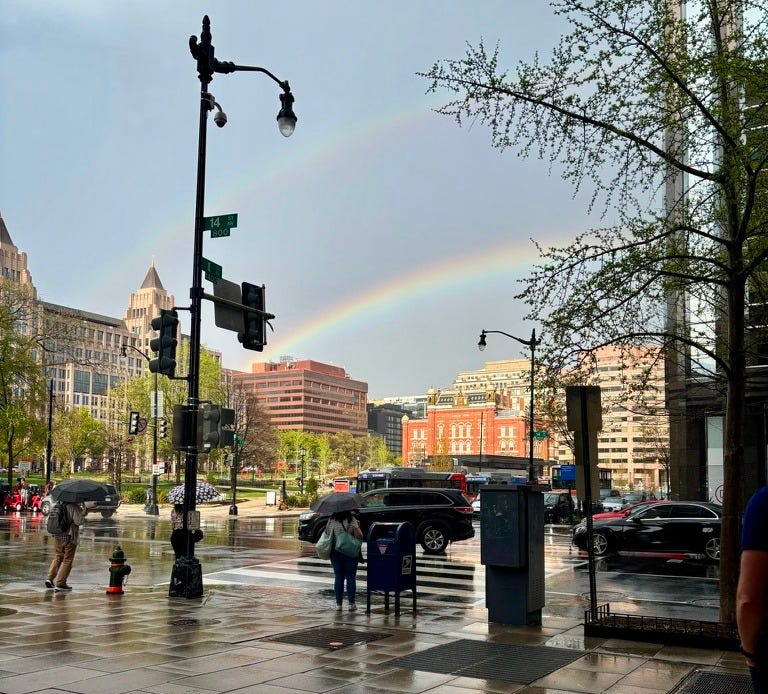These past few weeks, I’ve spent hours consuming content from the same three entrepreneurs on YouTube:
Daniel Dalen, Bruno Casanovas, and Marcus Milione.
Through their founder’s journey videos, these individuals fearlessly share the raw, chaotic, honest behind-the-scenes of their own growing businesses. Their content exudes energy, highlights their keen eye for aesthetics, and reinforces the ethos of their brand’s mission.
What makes them magnetic is how naturally they integrate themselves into their brands. Their taste, personality, and values are embedded in everything they do. And you begin to understand as the viewer, that these guys aren’t just representing the brand—they are the brand.
This is modern leverage.
Those who have read The Almanack Of Naval Ravikant will be familiar with the concept of leverage. Leverage is the ability to achieve a greater output with the same or less input. It's about working smarter, not harder, to achieve outsized returns.
One particular part of his book focuses specifically on taking accountability:
“Embrace accountability and take business risks under your own name. Society will reward you with responsibility, equity, and leverage.”
That’s exactly what these creators have done. They have tied their identity to their product, growing both in parallel. Their public presence clarifies their mission—not just for their followers, but likely for themselves too.
And in doing so, they’ve created a new kind of flywheel:
Documentation → Content → Taste → Community → Business
The more they document, the more content they create.
The more content they create, the sharper their taste becomes.
The sharper their taste, the more distinct their brand.
The more distinct their brand, the more powerfully it attracts community.
And through the momentum and resonance of that community, a business begins to grow.
Founders who are willing to take on more accountability, by fearlessly intertwining their taste and values with their brand, will be able to gain outsized support from the niche communities they resonate with.
That’s the context in which I’ve developed my understanding of the new brand economy. What I’ve articulated so far isn’t new—it’s been said before numerous times by those within the creator space. But it’s finally begun to click for me.
Let’s break it down.
Documentation becomes Content
Documentation is the distillation of total experience—taking the chaos of a point in time and freezing a single dimension of it—through words, sketches, images, video, etc.
Some forms of documentation are easier than others. Snapping a photo on your phone is probably as low friction as it gets. On the other hand, filming and editing a vlog is much harder.
Great documentation takes work. It asks for honesty and perspective when you journal. Other times, it demands technical skill, like learning to use a camera well enough to actually capture the emotion you felt in a moment. It can feel tedious, or self-indulgent, or like shouting into the void. Some forms feel like labor. Others, like therapy. For me, writing has felt like all of the above.
When you take what you’ve documented and share it on Instagram, YouTube, Substack, etc., documentation becomes content. And that’s where things get a bit dicey, because the term “content” has earned a terrible reputation in the post-covid years. It’s become synonymous for self-promotion and selling out.
But content, at its best, isn’t about performance. It’s about connection through documentation. It’s taking something personal and making it legible to others through distillation. It’s saying, This is what I saw. This is how it felt. Do you see it too?
If we all stop being so cynical about social media for a moment, aren’t the creators we love the most those who express their genuine selves online, not the ones chasing virality 24/7?
Documentation is inherently built on authenticity, because documentation is a reflection of hard work. To me, a meaningful life is one built around striving—striving to learn more about yourself, striving to become kinder, striving to maximize your true potential. That’s the type of stuff I want to document.
And to be able to share this process via content, to connect with others with similar perspectives and goals, is one of the more magical things we have left in this world.
Content becomes Taste
The content that you share—what captures your eye, what sticks in your mind, how you frame it—all of that adds up to something deeper.
Taste.
Taste isn’t just personal preference. It’s the act of noticing, curating, and shaping your worldview in public.
Just because you watch a lot of YouTube doesn’t mean you can make great videos. Just because you like listening to music and can break down what makes a song good doesn’t mean you can write one. Just because you wear a lot of clothes doesn’t mean you can design them.
Taste without creation is simply preference through consumption. And while all taste does start with intuition, in order to develop it into something tangible and original, you have to create—and then iterate. Over and over again. Taste differentiates itself from preference, because taste requires you to communicate your creative intuition effectively.
And that’s a muscle you can only build by trying, failing, refining, and trying again. Here’s Rick Owens sharing that same sentiment:



Recently, AI has made taste a thousand times more important. The barrier to creating pretty much anything has fallen. Anyone can come up with a business idea and use tools like ChatGPT to write a business plan, generate a logo, spin up a website, and draft an ad copy—all in under fifteen minutes.
The friction is gone, the tools are practically free, and the skill barriers have collapsed.
Which means execution is no longer the bottleneck. The bottleneck is taste.
It’s about being more you, with enough clarity and consistency, so that others begin to see the value in what you’re building.
Taste becomes Community
As your taste solidifies, it attracts community with similar interests.
People begin to gather around your content. Not because you were the loudest, or the sexiest, or the most controversial, but because something about your taste feels familiar.
When your taste is clear enough, when your brand reflects something people want to be part of, when you have put enough of yourself out there for the world to judge, you no longer have to shout. People will show up, and the size of your crowd will be in direct proportion to how valuable your taste is.
The harsh truth about building community is that people only show up if your taste is expressed in a way that engages them. This is where the somewhat ambiguous line between audience and community is drawn. If you push virality too hard, chasing trends and clicks, you might build a large audience, but it’ll be a shallow group of people. On the other hand, if you focus on establishing real connection, you will build community.
But even if your intentions are pure, even if you’re pouring your heart into the work, none of it matters if you can’t communicate that energy—clearly, consistently, and with emotion. Unless you learn how to transfer that spark to others, no one will see what you’re building.
Daniel, Bruno, and Marcus (the three creators I mentioned at the start) didn’t set out to build communities. They set out to build something real. And by being radically open about their unique journey—their own decisions, their own anxieties, their own wins—they gave others something genuine to identify with.
Pixar’s first rule of storytelling is that you admire a character more for trying than for their successes. Similarly, people are more gravitated toward those who are working toward a greater mission, rather than those who have already reached the top.
People no longer gather around products. They gather around meaning. When your brand reflects something people care about—something they want to embody—they join in.
Community becomes Business
As alluded to above, the difference between audience and community is participation.
An audience watches from afar, noticing your work on their explore page, maybe giving it a like, but ultimately moving on. They enjoyed the brief, serendipitous encounter that the algorithm facilitated, but the story ends there.
A community gets involved. They leave comments, they share your work even without you asking, they celebrate successes with you, and yes, they even unfollow you when they no longer resonate with what they see.
We’re all a part of multiple communities: schools, nationalities, sports teams, etc. We support them not because we still attend the school or play on the field, but because we feel like we’re a part of the team, even if we’re not. That feeling isn’t us being delusional. These brands have given us enough reason and reassurance to believe that we belong, and that we are an important part of their community and heritage.
That’s the power of identification. When people see your brand as a reflection of themselves—something that echoes their values, aspirations, or quirks—they begin to root for it like it’s their own.
And in the new brand economy, brand is the business. The emotional connection comes first and transactions are simply a byproduct of belief. No matter what service you provide—a hoodie, a candle, a latte—it almost doesn’t matter.
The product is just a vessel for something deeper. If people resonate with what you stand for, they’ll show up for whatever form it takes.
That’s what makes this moment so different. The barrier to creating anything is a $20 ChatGPT subscription, and online distribution is practically infinite. When anyone can make anything—and put it in front of the entire world—the only real differentiator left is how deeply people care.
And despite all the noise about how we’re living in an loneliness epidemic, surprise surprise, people still care about people, about story, about community.
That’s what has resonated since the beginning of time, and it’s not going to change. Ever.
For those seeking a creative, entrepreneurial career, the ability to build and sustain brand presence—to run the self-nourishing loop of documentation, content, taste, community, business—is the single greatest skill one can acquire.
It’s a theory I believe in.
And now, I’m going to put it to the test.







Hey Raymond if you haven't heard of them check out Chris Do from The Futur and Johnny Cupcakes! I learned so much about branding and taste from Chris and Johnny is the owner of a popular clothing brand. https://www.youtube.com/watch?v=UIiPbEdpqhc&t=663s
Where in this path do you believe you're in? It seems to me that maybe once one has gone through this process, they might be able to grow each area in tandem.
Is there a particular stage that you think would be particular challenging? How do you think you would overcome those challenges?